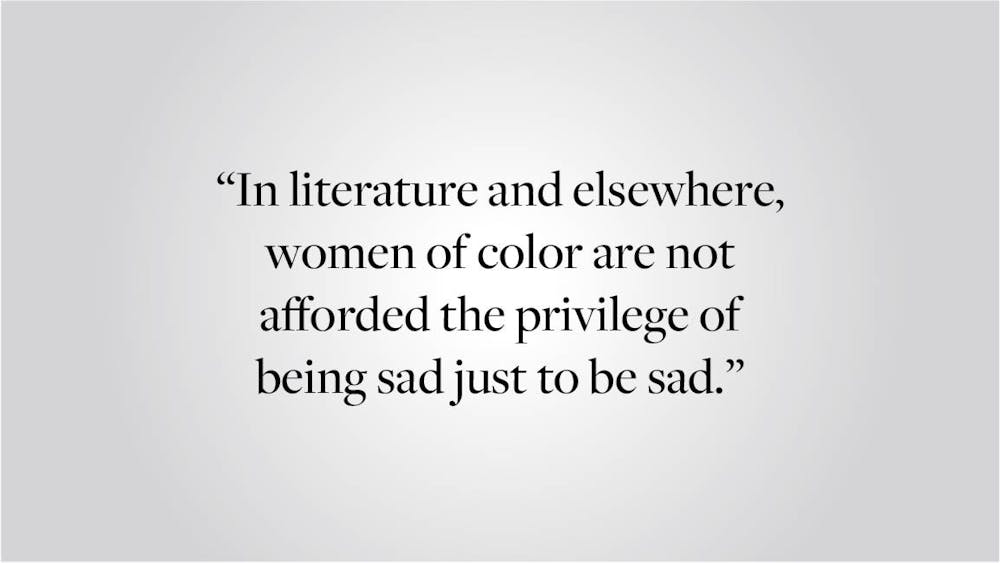From Sylvia Plath to Lana Del Rey, many women artists have embraced a keen sort of sadness that feels both delicately feminine and inseparable from their womanhood. It is not the kind of sadness that can be gone and forgotten after a few good cries. It is all-encompassing: an illogical, inexplicable sorrow with no real cause and no real solution. It is complex and petty and pathetic.
I call this exploration of feminine sadness in art the “sad girl trope.” This trope is particularly common in literature, with modern female authors like Sally Rooney depicting similar archetypes of depressed, unhinged women. If done right, the sad girl trope can be an empowering subversion of the portrayal of one-dimensional women. But the literary sad girl is almost always white, well off and sexually desirable. Thus, instead of empowerment and liberation, the sad girl trope romanticizes a type of feminine mental instability that is only relatable when the subject is not racially or economically marginalized. In other words, the sad girl trope primarily represents wealthy white women while leaving no room for historically oppressed women of color, a literary trend that plays into harmful stigmas about non-white mental illness.
In classic literature, Sylvia Plath’s “The Bell Jar” is one of the most well-known and iconic depictions of feminine sadness. In “The Bell Jar,” we see the protagonist battle depression, solitude and ostracization from society. Sadness encompasses and defines the novel. More recently, novels like Ottessa Moshfegh’s “My Year of Rest and Relaxation” similarly explore these themes of sadness and mental instability. The novel follows an unnamed protagonist who uses prescription medications to try to sleep for an entire year in an attempt to escape the grief and dissatisfaction that plagues her life. Sally Rooney’s “Beautiful World, Where Are You?” and Elif Batuman’s “The Idiot” are other modern novels that parallel this trend in their depiction of female protagonists attempting to navigate confusion, loneliness, apathy and depression. In all of these examples, these women’s identities are defined by their sadness. The emotion dictates the illogical and cloudy ways that they think and feel and act. This is what makes them so relatable — like so many women, they have unhealthy coping mechanisms, lash out in the face of hardship and struggle to navigate a world where everyone else seems to know what they are doing.
This relatability, however, is unequivocally tied to these characters’ whiteness. When women of color are protagonists in literature, their stories often center around their racial identities and the ways they are oppressed and empowered by such identities. In works that feature women of color, sad female protagonists are thus almost always shaped and defined by racial trauma — think Toni Morrison or Zora Neale Hurston. This racial trauma is incredibly important for literature to explore. But it also points to the disparities that exist between depictions of mental instability between white women and women of color. For white women, sadness is feminine and relatable with no root cause or single culminating event. For women of color, sadness is tied to centuries of historical racial violence of which their pain is representative. In literature and elsewhere, women of color are not afforded the privilege of being sad just to be sad.
The relatability that comes with feminized mental instability and sadness in literature like “The Bell Jar” exists because the characters these tropes deal with are all white. Whiteness is inherently intertwined with femininity. White women remain the beauty standard and the default. The sad girl trope is thus inseparable from white womanhood. The sad girl trope can only ever represent white women, whose whiteness allows them to be a kind of feminine that women of color could never attain. White women, as standards of societal femininity, are therefore entitled to relate to these complex literary women and see themselves represented in this trope.
On the flip side, women of color have been historically represented as undesirable and unfeminine. As opposed to the standard femininity that white women have, women of color are stigmatized as different or uncommon. The sad girl trope is thus strikingly and overwhelmingly bare of any women of color because women of color are not seen as inherently relatable or desirable the way that white women are.
This absence of women of color in the sad girl trope also has harmful consequences on the ways we view and stereotype non-white femininity and mental illness. Today and historically, non-white mental illness has been criminalized within political and social spheres. A lack of sufficient mental health and social program funding, coupled with the over-policing and oversaturated violence that exists within communities of color, have contributed to a culture of treating mental illness within non-white people with brutality, force and incarceration. The absence of women of color in the sad girl trope, by reinforcing the idea that a woman’s mental illness is only relatable when she is white, is thus complicit in this harmful characterization of non-white mental illness. Without literature that features women of color undergoing sadness for sadness’s sake, it is more likely that non-white mental illness will be seen as criminal rather than relatable and as a reason for ostracization rather than a reason for support.
Women of color deserve more explorations of feminine sadness and emotional complexity in literature. They deserve to make bad decisions, to be flawed and to struggle with mental illness in ways that are not directly tied to racism or their racial identity. We get sad sometimes, too.
Melissa Liu ’25 can be reached at melissa_y_liu@brown.edu. Please send responses to this opinion to letters@browndailyherald.com and other op-eds to opinions@browndailyherald.com.





